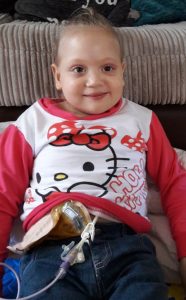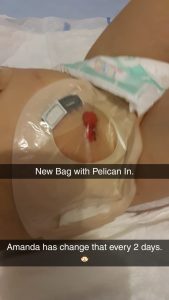Natasha from Disabled Living interviewed Amanda Morgan, mother of a young girl called Alyssa who lives with a stoma.
Alyssa will be 4 years old this December. She has a condition called Dyskeratosis congenita (DC) Hoyeraal-Hreidarsson (HH) syndrome. This was diagnosed when she was 18 months after falling very ill at 13 months old. We found out she had brain abnormalities at 9 months old causing a movement disorder.
At 13 months Alyssa became paralysed in both legs and her left arm. Results showed transverse myelitis (inflammation of the spinal cord). At the same time, blood results came back low for Hemoglobin (Hb), platelets and white cells. Alyssa had her first blood and platelet transfusion. Tests revealed that Alyssa has DC HH syndrome. This caused her bone marrow to fail leading to a bone marrow transplant at 18 months old. She experienced gut failure which caused internal bleeding.
Expanding on Alyssa’s story, Amanda told us:
The peg was fitted in May 2016. During August 2016 – August 2017, she had all of her nutrition given by total parenteral nutrition (TPN). Now she is 3 nights TPN and 4 nights with fluids by central line and has 590 millilitres peg feed daily. She has had 104 platelet transfusions and 35 blood transfusions; sepsis 5 times; is on her 6th central line and on her 2nd peg; has liver disease and we’re waiting for tests to see if she has lung disease (hopefully not).
December 2017 was when Alyssa fell ill again. This time she nearly lost her life. She was admitted to the Intensive Care Unit (ICU) at Southampton General Hospital while on holiday. She suffered a sepsis related infection due to a buried peg bumper. The peg was first removed not knowing the full extent until hours later; she went down for emergency open stomach surgery.
Alyssa became progressively worse and saturation was dropping. She was put on the ventilator and rushed to theatre. The infection had spread into her lungs and throughout her colon. She had a blood clot and 15cm of her small bowel was removed. This is when Alyssa had her ileostomy done on the 21st December 2017 just after her 3rd birthday.
Have there been any challenges you have faced as a family when it comes to caring for your daughter?

Now Alyssa still has her ileostomy and hopefully she can be reversed in early 2019. However, when Alyssa first had the stoma it was a big challenge getting used to emptying it and changing the bag. It took a while to find what worked best for her e.g. the step by step process of changing the bag and keeping her calm whilst emptying the bag. At first the bag was constantly leaking. The staff nurses on ICU and High Dependency Unit (HDU) would put the bag on and it would leak. It was very stressful and painful for Alyssa and us.
The stoma nurse shown me how to do it. The most challenging part was cutting the bag correctly as the shape resembles a number 8. Getting the new bag on while Alyssa was constantly pooing was difficult. Within a week, I got used to doing the stoma and mastered cutting the bag correctly by 4 weeks.
How has living with a stoma affected your daughter’s life? (Any restrictions doing daily activities, leisure, etc.)
Alyssa has tried different products to help with ulcerations and we’re pleased that these products now work well for her. Every 2 days I change her bag. She has got used to it so she is aware it’s there. But due to her delayed development it doesn’t affect her mentally or socially.
Once the bag is off I clean it with warm water, put Medi Derma-S applicator around her stoma. Then I check if the bag fits what I have cut out using a template of the previous cut out. Next, the seal goes on and DuoDerm for extra skin protection. The bag goes on keeping my hand over it for 3 minutes to help it stick better and lastly coloplast goes around the stoma bag and a pelican perform sachet goes into the bag to soak up Alyssa’s diarrhoea and helps with leakage.

It can still be a challenge now to change the bag if Alyssa’s output has increased. When going out, emptying the bag and changing her nappy is inconvenient as I have to do this on the back seats of our car as majority of places don’t have mobility changing facilities. With simple things such as shopping, we wait until Alyssa has had her stoma emptied before going out as she also suffers from fatigue. Usually, we wait until she has napped for two hours.
We feel we are limited to times and where we can go, such as holiday destinations that are mobility friendly. The stoma is not the only problem. Alyssa cannot walk and recently, we have started using hoist systems to transfer her. This is a big problem now when trying to go out.
What advice do you have for other parents who have a child with a stoma?
It can be a shock when you see your child’s stoma for the first time but I would like to think anyone can adjust to living with a stoma and the ones who cares for the stoma. It may take time and that’s okay. With positive thinking and talking about any issues you have could help adjust.
Even though Alyssa doesn’t understand, we accept that she may have a stoma for life for good reasons but it doesn’t change who Alyssa is. She is still our funny beautiful little girl. It was hard to be positive at times but for Alyssa’s sake we pulled together and make everything fun for Alyssa to concentrate on the positives.


Comments are closed